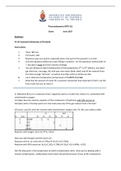Exam (elaborations)
Mtx 311 2017 exam memorandum
- Course
- MTX 311 (MTX311)
- Institution
- University Of Pretoria (UP)
Exam memorandum for MTX311 2017 worked out solutions. The memorandum has solutions are 100% correct including alternative working methods. The solutions are done in a step by step matter
[Show more]




